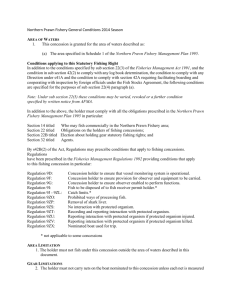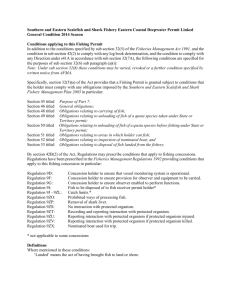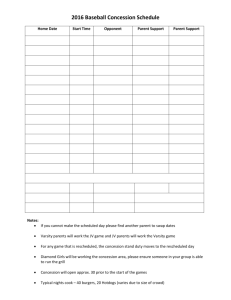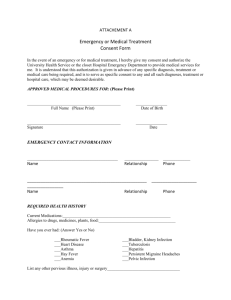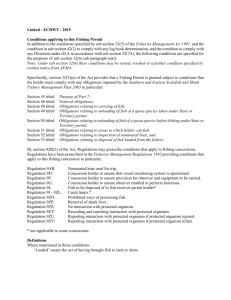SA Coastal Waters Permit Linked General Conditions 2015 season
advertisement
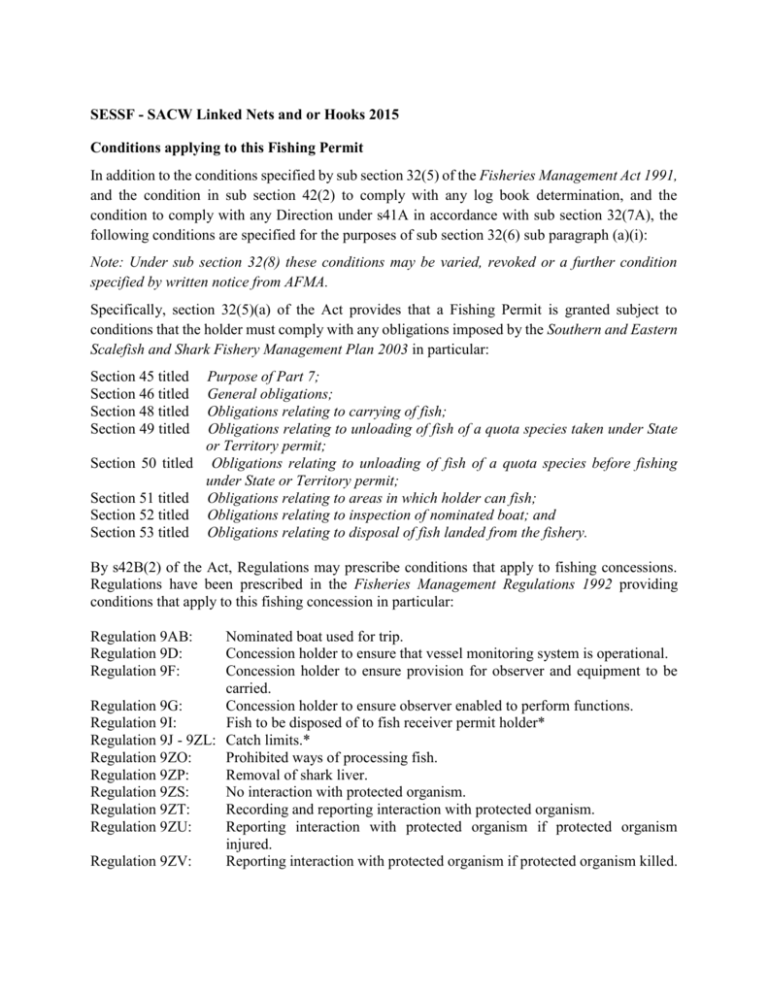
SESSF - SACW Linked Nets and or Hooks 2015 Conditions applying to this Fishing Permit In addition to the conditions specified by sub section 32(5) of the Fisheries Management Act 1991, and the condition in sub section 42(2) to comply with any log book determination, and the condition to comply with any Direction under s41A in accordance with sub section 32(7A), the following conditions are specified for the purposes of sub section 32(6) sub paragraph (a)(i): Note: Under sub section 32(8) these conditions may be varied, revoked or a further condition specified by written notice from AFMA. Specifically, section 32(5)(a) of the Act provides that a Fishing Permit is granted subject to conditions that the holder must comply with any obligations imposed by the Southern and Eastern Scalefish and Shark Fishery Management Plan 2003 in particular: Section 45 titled Section 46 titled Section 48 titled Section 49 titled Purpose of Part 7; General obligations; Obligations relating to carrying of fish; Obligations relating to unloading of fish of a quota species taken under State or Territory permit; Section 50 titled Obligations relating to unloading of fish of a quota species before fishing under State or Territory permit; Section 51 titled Obligations relating to areas in which holder can fish; Section 52 titled Obligations relating to inspection of nominated boat; and Section 53 titled Obligations relating to disposal of fish landed from the fishery. By s42B(2) of the Act, Regulations may prescribe conditions that apply to fishing concessions. Regulations have been prescribed in the Fisheries Management Regulations 1992 providing conditions that apply to this fishing concession in particular: Regulation 9AB: Regulation 9D: Regulation 9F: Nominated boat used for trip. Concession holder to ensure that vessel monitoring system is operational. Concession holder to ensure provision for observer and equipment to be carried. Regulation 9G: Concession holder to ensure observer enabled to perform functions. Regulation 9I: Fish to be disposed of to fish receiver permit holder* Regulation 9J - 9ZL: Catch limits.* Regulation 9ZO: Prohibited ways of processing fish. Regulation 9ZP: Removal of shark liver. Regulation 9ZS: No interaction with protected organism. Regulation 9ZT: Recording and reporting interaction with protected organism. Regulation 9ZU: Reporting interaction with protected organism if protected organism injured. Regulation 9ZV: Reporting interaction with protected organism if protected organism killed. * not applicable to some concessions Definitions Where mentioned in these conditions: ‘Landed’ means the act of having brought fish to land or shore. Authorised Species 1. This concession authorises fishing for the following species only: a) School shark (Galeorhinus galeus); and b) Gummy shark (Mustelus antarcticus). Finfish Obligations 2. Under the Southern and Eastern Scalefish and Shark Fishery Management Plan 2003 the holder must not take any tuna or tuna-like species as specified below: a) Fish of the Family Scombridae, except fish of the Genera Scomberomorus, Acanthocybium, Grammatorcynus and Rastrelliger (commonly known as mackerels); and b) Fish of the Families Istiophoridae (commonly known as marlins) and Xiphiidae (commonly known as billfish). 3. Any take of the following Eastern Tuna and Billfish Fishery quota species is to be taken in accordance with the Eastern Tuna and Billfish Fishery Management Plan 2010: a) Albacore tuna (Thunnus alalunga) b) Bigeye tuna (Thunnus obesus) c) Broadbill Swordfish (Xiphias gladius) d) Striped marlin (Tetrapturus audax) e) Yellowfin tuna (Thunnus albacares). 4. The holder must not take flathead less than 280 millimetres in length when measured from the point of the snout to the tip of the tail. Shark Obligations 5. Retained and/or landed School Shark (Galeorhinus galeus) and Gummy Shark (Mustelus antarcticus) must exceed 450 millimetres when measured in a straight line from the middle of the posterior edge of the aftermost gill-slit to the ventral insertion of the caudal fin. 6. The holder must not take, or engage in fishing for, the species School Shark (Galeorhinus galeus) unless: a) the holder holds five times more Gummy Shark (Mustelus antarcticus) quota (caught and uncaught) than the amount of School Shark that the holder has taken; or b) at the end of the: i. first period, the holder has taken less than 250 kilograms of School Shark (trunked weight) in that period; ii. second period, the holder has taken less than 500 kilograms of School Shark (trunked weight) in that period; or iii. third period, the holder has taken less than 750 kilograms of School Shark (trunked weight) in that period. 7. In these conditions: a) ‘first period’ means the roughly three month period from 1 May through to the last Friday in July of each fishing year; b) ‘second period’ means the roughly six month period from 1 May through to the last Friday in October of each fishing year; and c) ‘third period’ means the roughly nine month period from 1 May through to the last Friday in January of each fishing year. 8. For the purpose of determining compliance with these conditions, the holding of caught and uncaught quota of Gummy Shark and amount of School Shark taken must be calculated on each quota and catch balancing date, being: a) 5pm Eastern Standard Time 12 August of each fishing year, for the first period. If 12 August falls on a weekend or a public holiday, the balancing date moves to the next business day; b) 5pm Eastern Standard Time on 11 November of each fishing year, for the second period. If 11 November falls on a weekend or a public holiday, the balancing date moves to the next business day; and c) 5pm Eastern Standard Time on 14 February of each fishing year for the third period. If 14 February falls on a weekend or a public holiday, the balancing date moves to the next business day. Note: For example, if, at the end of the first period the person has taken 600 kilograms of School Shark, the holder must hold at least 3 tonnes of Gummy Shark quota (600 kilograms x 5) on the ‘quota and catch balancing date’. 9. If any school shark (Galeorhinus galeus) are taken alive, they must be returned to the water alive. 10. The holder must not retain Harrisson’s Dogfish (Centrophorus harrissoni), Endeavour Dogfish (C. moluccensis), Southern Dogfish (C. zeehaani) and Greeneye Spurdog (Squalus chloroculus). If any of these species are taken alive, they must be returned to the water carefully and quickly. 11. The holder must not carry or possess any shark (Class Chondricthyes) dorsal, pectoral, caudal, pelvic or anal fins on board the boat nominated to this concession that are not attached to the shark’s carcass. Quota Balancing obligations 12. a) The holder must not be over quota for any quota species. b) The holder is not considered to be over quota for a species if, within 28 days of landing an amount (by weight) in excess of their uncaught quota recorded in the Register, the holder acquires a further amount of quota for that species which is equal to or greater than the excess. c) If the holder is over quota for any quota species AFMA may suspend this concession in accordance with this condition, pursuant to section 38(1)(c) of the Fisheries Management Act 1991. In deciding whether to suspend or lift the suspension of this concession AFMA must take account of any written explanation from the holder detailing any exceptional circumstances as to why the holder was over quota. d) Any dealing in a quota Statutory Fishing Right by the holder of a boat Statutory Fishing Right or Fishing Permit for the purpose of complying with this condition must be lodged with AFMA duly executed and in the form approved by AFMA, on or before the 28th day from which the excess quota species was landed. For the purpose of determining if the holder is over quota under this condition, any acquisition of quota for a species may only be deemed to have been acquired up to 28 days prior to the date of registration of that acquisition of that quota species. e) If this concession is suspended, unless the holder has acquired and AFMA has then recorded in the Register (but may not deem) an amount of uncaught quota for which the holder is over quota, this concession may, under this condition, again be suspended upon expiration of the earlier suspension. In this condition: Acquire means receiving Statutory Fishing Rights by registering a dealing by which an amount of Statutory Fishing Rights are permanently or seasonally transferred to the holder; and acquisition has a comparable meaning. Quota species has the same meaning as quota species in the applicable management plan for which this concession has been granted and established under the Fisheries Management Act 1991. Over quota means when the holder lands an amount of quota species in excess of the available uncaught amount recorded for that species in the holder’s name on the Register. Register means the Register of Statutory Fishing Rights kept by AFMA pursuant to section 44 of the Fisheries Management Act 1991 Observer/Monitoring Obligations 13. When directed by AFMA the holder must: a) give the AFMA Observer Section at least 72 hours notice of an intention to depart on a fishing trip, by telephone (02 6225 5506, or 0427 016 859) or by email: observers@afma.gov.au; and b) ensure that the boat does not leave port until: i. AFMA has notified the holder, or a person acting on behalf of the holder, whether it directs that an observer is to be carried on the boat; and ii. if the boat is equipped with electronic monitoring equipment, an electronic monitoring function test has been completed, AFMA has been notified of the result of the test, and AFMA has notified the holder, or a person acting on behalf of the holder, that it is satisfied that the equipment is working correctly. Note 1: These conditions are in addition to the conditions concerning the taking of observers that are prescribed in the Fisheries Management Regulations 1992 (the Regulations). Those conditions are in Schedule 1, Division 3, regulations 9E to 9G Note 2: AFMA may direct under the Regulations that an observer be carried, even if electronic monitoring equipment is installed and is to be operated. Observer/Monitoring Obligations in closure areas 14. In these conditions the ‘Australian Sea Lion Management Zone’ means that part of the Australian Fishing Zone and the South Australian Coastal Waters Sector that is east of the parallel of longitude 129° east and west of the parallel of longitude 139° east. 15. In these conditions the ‘Dolphin Observation Zone’ means the area of waters: a) starting at the intersection of longitude 136° 33' 55"E and the low water mark on the southern coast of Kangaroo Island; b) then South to the intersection with the 183m line at 36° 34' 44"S and 136° 33' 55"E; c) then following the 183m line in a SE direction (via points 22 to 42 of the 183m gillnet closure) to 38° 26' 35"S and 140° 58'E; d) then North to the intersection with the 3 nautical mile line at 38° 06' 29"S and 140° 58'E; e) following the 3 nm line North West to 37° 08' 42"S off Cape Dombey and 139° 40' 30"E f) then North West to 37° 00'S 138° 50'E; g) then North West to 36° 24'S 137° 08'E; h) then North to the intersection of 137° 08' and the low water mark on the southern coast of Kangaroo Island; and i) then West to the point of commencement. 16. In these conditions the ‘Coorong Dolphin Zone’ is the part of the Australian Fishing Zone and coastal waters of the State of South Australia contained within and bounded by a line: a) Starting at the intersection of 137° 08'E and the low water mark of Kangaroo Island; b) Then south to 36° 24'S 137° 08'E; c) Then southeast to 37° 00'S 138° 50'E; d) Then southeast to the intersection of 37° 09' 24"S and the low water mark of the coast of mainland Australia in the vicinity of Cape Dombey; e) Then generally northwest along the coast of mainland Australia to the intersection of 138° 08'E and the low water mark; f) Then south to the intersection of 138° 08'E and the low water mark of Kangaroo Island in the vicinity of Cape Willoughby; g) Then generally southwest along the coast to the point of commencement. 17. The holder must not fish using gillnet methods in any part of the Australian Sea Lion Management Zone, the Coorong Dolphin Zone or the Dolphin Observation Zone unless: a) an AFMA nominated observer is carried on the boat nominated to this concession; b) electronic monitoring equipment approved by AFMA is installed on the boat nominated to this concession, is operated to record all fishing activity, and the data recorded is returned to AFMA, in accordance with the directions of AFMA; or c) AFMA authorises otherwise in writing. Note : This condition does not authorise fishing by a method in an area prohibited under the Southern and Eastern Scalefish and Shark Fishery (Closures) Direction No. 1 2015. 18. If the boat nominated to this concession is equipped for fishing using gillnet methods, the holder must not depart on a fishing trip to fish in the Australian Sea Lion Management Zone, the Coorong Dolphin Zone or the Dolphin Observation Zone, whether the fishing method intended to be used is hook methods or gillnet methods, unless: a) an AFMA nominated observer is carried on the boat nominated to the concession; b) electronic monitoring equipment approved by AFMA is installed on the boat, is operated to record all fishing activity, and the data recorded is returned to AFMA, in accordance with the directions of AFMA; or c) AFMA authorises otherwise in writing. 19. If required to carry an observer, the holder must: a) give the AFMA Observer Section at least 72 hours notice of an intention to depart on a fishing trip, by telephone (02 6225 5506, or 0427 016 859) or by email: observers@afma.gov.au <mailto:observers@afma.gov.au> ; and b) ensure that the boat does not leave port until: i. AFMA has notified the holder, or a person acting on behalf of the holder, whether it directs that an observer is to be carried on the boat; or ii. if the boat is equipped with electronic monitoring equipment, an electronic monitoring function test has been completed, AFMA has been notified of the result of the test, and AFMA has notified the holder, or a person acting on behalf of the holder, that it is satisfied that the equipment is working correctly. 20. The holder must ensure that, if the boat is equipped with electronic monitoring equipment, the equipment is working at all times that the boat is operating in the Australian Sea Lion Management Zone or the Dolphin Observation Zone, unless AFMA authorises otherwise in writing. Note 1: These conditions are in addition to the conditions concerning the taking of observers that are prescribed in the Fisheries Management Regulations 1992 (the Regulations). Those conditions are in Schedule 1, Division 3, regulations 9E to 9G Note 2: AFMA may direct under the Regulations that an observer be carried, even if electronic monitoring equipment is installed and is to be operated. Agent Obligations 21. The holder accepts concurrent liability for all conduct by its servants or agents infringing the Fisheries Management Act 1991 (or the Regulations, Management Plans or concession conditions made by virtue of that Act) who may be engaged by the holder to conduct on the holder’s behalf activity under this concession. 22. Liability for the conduct of the holder’s servants or agents arises, even if the conduct may be, or actually is, beyond the scope of the servant or agent’s actual or apparent authority where it is a breach that occurs during the conduct of activity authorised by this concession. 23. The holder may avoid concurrent liability for conduct whilst conducting activity under this concession if, but only if, the holder can establish that the infringing conduct could not possibly have been prevented by any action or precaution that the holder might have reasonably taken. 24. The giving of an indemnity by the servant or agent to the holder for any penalties incurred by the holder, for infringing conduct by the servant or agent is not, of itself, a reasonable precaution to prevent infringing conduct. Direction Obligations 25. The holder must comply with any Direction that fishing is not to be engaged in in the fishery, or a particular part of the fishery or during a particular period or periods made under sub section 41A of the Fisheries Management Act 1991. Temporary Orders Obligations 26. The holder must comply with any Temporary Order made under sub section 43(2) of the Fisheries Management Act 1991 and to the extent that any provision herein is inconsistent with such Temporary Order sub section 43(9) provides that the provision herein is overridden by the Temporary Order until the Temporary Order ceases to have effect. Navigating in Closed Zones 27. AFMA may suspend this concession in accordance with this condition, pursuant to section 38(1)(c) of the Fisheries Management Act 1991, if it reasonably appears by VMS transmission from the nominated boat, that there is a failure by that boat while in a closed zone for the purposes of regulation 37B of the Fisheries Management Regulations 1992, to meet the exempting provisions of sub regulations 37C(2), or (3) or sub regulation 37D(2) or (3). Such suspension will then continue until the concession holder provides a full written explanation, to the satisfaction of the delegate responsible for issuing that suspension, of the lawful reason for the boat being in that closed zone at that time, or until the expiration of the suspension under sub section 38(2); whichever is the earlier. Concurrent Conditions 28. This concession must only be used in conjunction with another concession held by the same holder namely a fishing concession issued by the state of South Australia that authorizes the use of the same fishing equipment allowed under this concession and a Southern and Eastern Scalefish and Shark Fishery Boat Statutory Fishing Right (“that other concession”) such that: a) The conditions of that other concession apply (to the extent those conditions are not inconsistent and are capable of doing so) as conditions of this concession. b) A breach, suspension or cancellation of that other concession is a breach, suspension or cancellation of this concession. c) The conditions of this concession apply (to the extent these conditions are not inconsistent and are capable of doing so) as conditions of that other concession while it is being used in conjunction with this concession. d) A breach, suspension or cancellation of this concession is a breach, suspension or cancellation of that other concession. Area Limitation 29. The holder must not fish under this concession outside the area of waters described in this document 30. The holder may only fish both inside 3 nautical miles and outside 3 nautical miles on the same trip if: a) The boat nominated to this concession is also nominated to a Scalefish Hook Boat Statutory Fishing Right, Shark Hook Boat Statutory Fishing Right or Gillnet Boat Statutory Fishing Right granted under the Southern and Eastern Scalefish and Shark Fishery Management Plan 2003; b) While fishing inside 3 nautical miles all gear on board the nominated boat above the amount specified in these conditions is stowed and secured at all times; Gear Limitations 31. This concession authorises the use of the following gear only: a) Gear detailed in Attachment A. 32. If this concession allows fishing by gillnets, the holder must measure a mesh in a net in the following way: a) Before a measurement is taken, the part of the net to be measured must be soaked in water for at least 5 minutes; b) Immediately after the net has been soaked the part of the net to be measured must be suspended vertically. The distance between the inside edge of the knot and the inside edge of the knot in the diagonally opposite corner of the mesh immediately above the first knot must be measured; c) The measurement must be rounded to the nearest 1.6 millimetres; and d) The average of the 10 measurements must be taken as the size of the mesh in the net. A mesh in a gillnet must be: i. greater than or equal to 150 millimetres in width; and ii. less than or equal to 165 millimetres in width. Removal of biological material and offal 33. If fishing with gillnets, the holder must completely remove all biological material from a gillnet before setting or re-setting the net. 34. The holder must not discard processing waste, including offal, from the nominated boat while a gillnet is being set or re-set. Move on Provisions and Reporting Obligations 35. If a dolphin is caught then the boat nominated to this concession must cease fishing immediately and not fish using gillnets at any point within a five nautical mile radius of that gear set before fishing can recommence. 36. As soon as practicable, but in any event no later than 48 hours after the cessation of a trip, the holder must notify AFMA’s Service One section of any dolphin bycatch event. The notice may be made by phone on 1300 723 621 or by email on licensing@afma.gov.au <mailto:licensing@afma.gov.au>. The holder must also complete a Dolphin Bycatch Evaluation Report and submit to AFMA. Other Obligations 37. If a boat is nominated to this concession, at all times when the boat is being used under this concession, the holder must have provided to AFMA a current emergency contact facility for the nominated boat. 38. An emergency contact facility must enable AFMA to contact the boat immediately and directly at any time when the boat is at sea, including in the event of an emergency. 39. AFMA must be notified immediately of any change in contact details, by fax sent to (02) 6225 5440 or by email to licensing@afma.gov.au; and the boat must not depart on a fishing trip unless AFMA has been so notified of the change in contact details. Note: The emergency contact facility may take the form of a satellite phone number, or skipper or crew member’s mobile phone number - any number that may be used by AFMA to contact the boat while it is at sea at any time, including in the event of an emergency. MANDATORY AFMA SUPPLIED VMS 40. Direction to Fit 1. When directed by AFMA in writing, the concession holder (or a person acting on the holder’s behalf) must; a. make available, within 14 days of the date of the written direction, the boat nominated to this concession for the purposes of installation of an AFMA Vessel Monitoring System unit (AFMA VMS unit) by an AFMA approved technician, and b. Provide all reasonable assistance to the AFMA approved technician including (but not limited to); i. the provision of an un-interrupted connection to the boat’s main power source, and ii.an appropriate position for the mounting of the AFMA VMS unit. 2. When directed by AFMA in writing, the concession holder (or a person acting on the holder’s behalf) must; a. make available, within 14 days of the date of the direction, the boat nominated to this concession for the purposes of removal of the AFMA VMS unit by an AFMA approved technician, and b. Provide all reasonable assistance to the AFMA approved technician. Concession holder must not interfere with AFMA VMS Unit 3. The concession holder (or a person acting on the holder’s behalf) must not interfere, or attempt to interfere, with the operation of the AFMA VMS Unit. Definitions: AFMA VMS Unit Means a Vessel Monitoring System (VMS) unit wholly owned by AFMA, marked with AFMA identifications and supplied by AFMA and fitted by an AFMA approved technician. Interfere For the purposes of these conditions ‘interfere’ includes, but is not limited to; Physical obstruction or removal of the AFMA VMS unit, or Deliberately disconnecting or otherwise interfering with the power supply to the AFMA VMS unit, or Deliberate physical interference with the casing or any external or internal components of the AFMA VMS unit. Notes Must Make boat available - Where the boat is not made available in accordance condition 1 (a) or 2(a), AFMA may suspend this concession pursuant to section 38(1)(c) of the Fisheries Management Act 1991. Must maintain VMS Unit - Regardless of AFMA’s decision to fit an AFMA VMS unit, the holder must continue to maintain a VMS unit in accordance with regulation 9D of the Fisheries Management Regulations 1992. Remains the property of AFMA - At all times the AFMA VMS unit remains the sole property of AFMA. The holder is liable for any costs incurred as a result of loss or damage to the unit.

